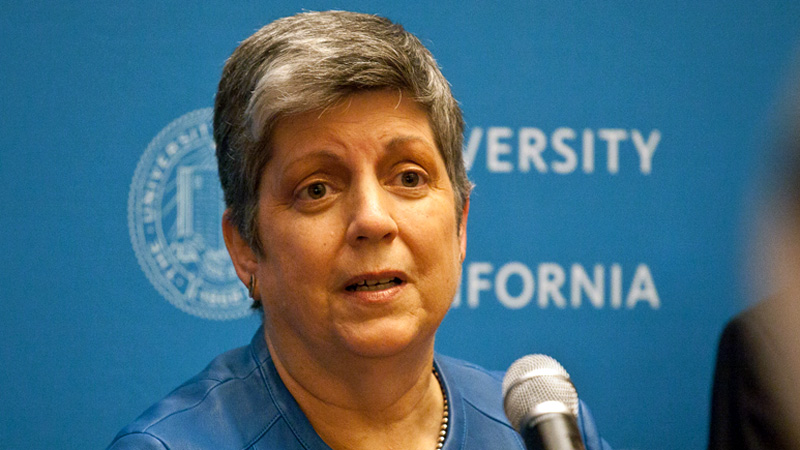Both private and public universities are committed to serving a wide range of students, but Napolitano said the numbers show the UC system is serving far more low-income students, with 42 percent of undergraduate students receiving Pell Grants, which is federal financial aid. Napolitano said 55 percent of UC students pay no tuition, about 40 percent are first-generation college students, and 20 percent come from a home where English is not the primary language.
“That's an amazing story,” Napolitano said. “If you added all of the Pell Grant students in the Ivy League -- added the whole Ivy League combined -- we have four, and maybe five campuses, each of which have more Pell Grant recipients.”
Napolitano recently told the Wall Street Journal that Stanford students are “hit on the day they show up with the idea that they are going to give back when they graduate.” She also said, “I don't think the public universities have done that, and they're going to have to.”
Napolitano herself went to Santa Clara University.
“We pretty much heard from the first day that we were going get a great education and we would be giving back over time once we had the financial wherewithal to do that,” she said.
Why have public universities lagged in terms of hitting up alumni?
“I think in part because the public -- I think in this case meaning the Legislature and the Governor -- were going to provide the public financing for the operational costs of the university,” Napolitano said. “With changing economics, with the impact of the recession in California, with the fact that the state appropriation for higher [education] has been so dramatically reduced, and has not come back up to what it was pre-recession, we now need to look at alternative or additional sources of revenue if we're gonna meet the excellence requirements that we have, and continue to teach the number of students that we do.”
What does Napolitano mean by alternative sources of revenue? In large part: alumni, friends of the university and grant funders.
But UCs are already doing pretty well on that score, according to Ann Kaplan, who directs an annual survey of U.S. college fundraising by the Council for Aid to Education in New York.
She drew up a list for KQED of the top 10 fundraising institutions of California, and notes seven of them are public.
“Most of those, if not all, are part of the University of California system,” Kaplan said.
Public universities keep up pretty well with gifts from alumni.
“In private institutions, alumni giving is about 29 percent of the gifts,” Kaplan said. “In publics, it’s about 23 percent. It’s not really as different as you would think.”
Who’s making up the difference? People who take a liking to a school for reasons other than having gone there. Or people who want their name on a sports stadium, concert hall, medical research center, and so on.
To recent graduates still living off instant noodles, contact from the fundraising department may seem ridiculous, even upsetting, but Kaplan said schools have to play the long game.
“You really don’t know now where somebody’s wealth is going to take them over the course of their lifetime. If you lose track of them in their 20s and 30s, you won't have the relationship,” Kaplan said. “I have a friend who did fundraising for a public university. [He] had a conversation for the 10 years that he worked with a donor who never gave any money. Ten years after my friend left, that donor made a multimillion dollar gift.”
There is a lot of wealth to be tapped, Kaplan said, and universities -- public and private -- are getting better at it as time goes on. In California, Stanford is the most successful. In 2012, the university became the first in the U.S. to rake in $1 billion in a single year.
Stanford didn’t respond to requests for an interview about that success.
More: U.S. News & World Report's ranking of national universities
